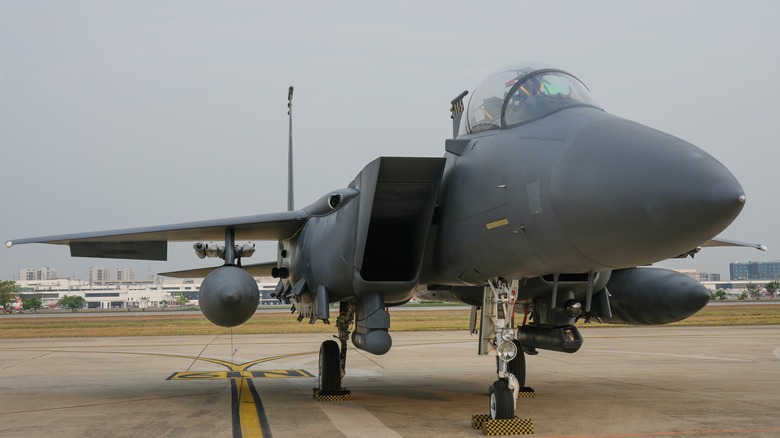This F-15 Was Able To Land With Just One Wing, Here's How
With 50 years of service under its belt, its capabilities and effectiveness continue to make the F-15 Eagle one of the most dominant jet fighters in the world. Throughout its service, the F-15 has consistently proved its air dominance, with a record of more than 100 kills and no losses. Built with powerful engines, remarkable maneuverability, and a sturdy airframe, its long service life is a testament to how well it is made. Able to carry a substantial payload, the Eagle can be armed with different weapons, adding to its versatility. The F-15 was designed for air superiority, and its engineering is also extraordinary, as seen when an F-15 was able to land safely despite missing a wing due to an accident.
The incident with the F-15 happened on May 1, 1983, in the Negev region of southern Israel. During that time, the Israeli Air Force was conducting training exercises where several aircraft were being flown, including an F-15D, piloted by Captain Zivi Nedivi, and his navigator, Yehoar Gal, and a Douglas A4 Skyhawk. During the dogfight training, the A-4 Skyhawk collided with the F-15D, causing it to disintegrate, but its pilot ejected safely. The F-15D, however, remained mostly intact, except for its right wing, which was ripped off during impact and was now plummeting to the ground.
Captain Nevidi was told to eject, but sensing he could still control the jet, decided to continue flying. By using the afterburners, the pilot slowly regained control of the F-15 and was able to maneuver toward the nearby airbase. To make it to base, Nevidi flew and landed at high speed, going 260 knots, which was twice the normal landing speed; despite this, the F-15 touched down, narrowly missing the barricades at the end of the runway.
Aeronautical engineering excellence
Despite having a badly damaged wing, the F-15 made a safe landing because of several factors, including the plane's design and the pilot's skill. While crippled by lack of a wing, the plane's fuselage, which serves as a lifting body provided enough lift to compensate for the wing loss. Next, the pilot utilized the F-15's powerful engines by engaging the afterburners to generate additional thrust and increase speed, thereby offsetting the decreased lift. The required speed to continue flying was achieved by the F-15D's max 23,770 pounds of thrust from its two Pratt & Whitney F100-PW-220 engines, and to this day, the F-15 is still one of the fastest jet fighters.
In addition, the F-15 was designed with several system redundancies that can allow it to continue flying even if damaged. Starting with hydraulics, the F-15 has three separate hydraulic systems, which can help maintain the jet if one fails. Alongside this is the digital, triple-redundant Lear Siegler flight control system, which is part of the navigation and control system. All of these combined made the F-15 highly durable, as seen when the damaged F-15D that flew with one wing was able to return to service two months later and, in 1985, shot down a Syrian MiG-23.
With its demonstrated success as a jet fighter, its ability to adapt and evolve to become even better has ensured its relevance in modern aerial warfare. With five decades of combat experience with numerous aerial victories, the F-15 remains a formidable aircraft. With its latest and most powerful variant, the F-15EX Eagle II, the F-15 is continuing its legacy with further technological advancements, solidifying its status as a proven platform.
